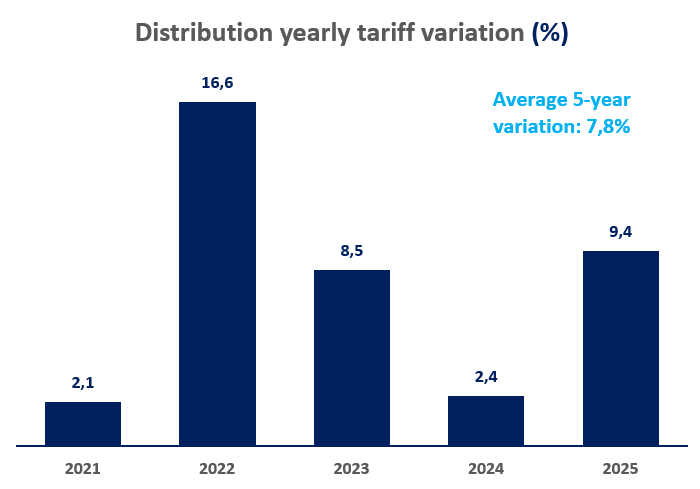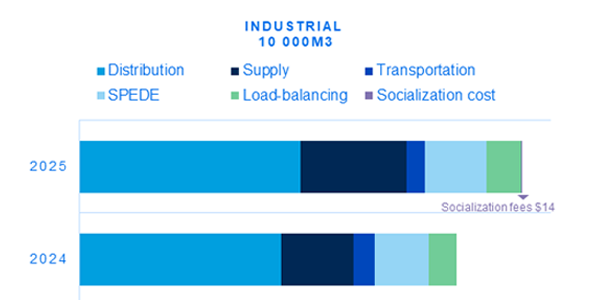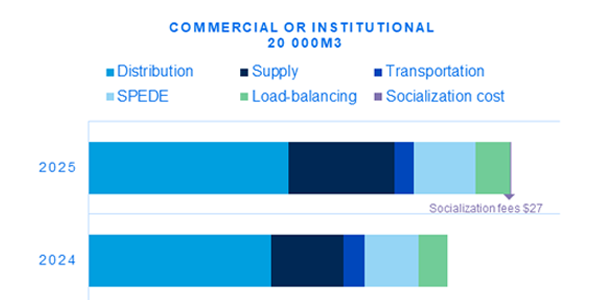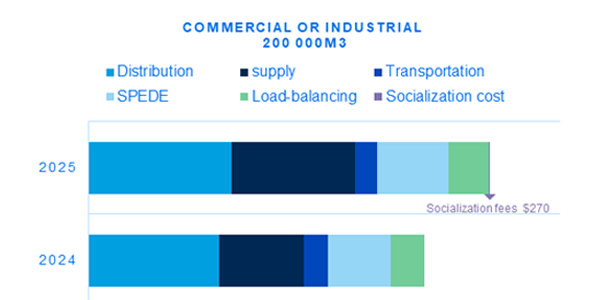New rates for fall 2024
Énergir’s proposed new rates were filed with the Régie de l’énergie on May 10 and are currently awaiting approval, with an intended application on October 1, 2023.
Learn more about our price changes in each section:
Price of Énergir's Services
Overall, for all of Énergir’s services, the 2024–2025 rate case results in a rate increase in prices of 7.65% on average , broken down as follows:
- Increase in distribution rates of 9.4% on average
- Drop in transport prices by 8.1% on average
- Increase in balancing tariffs of 12.1% on average
- Addition of the GNR socialization fee
Énergir's distribution rates, for the 2024-2025 financial year, are up 9.4% on average. The main contributors to the increase are as follows:
- Declining volumes, mainly in the small and medium-sized volume market, have meant lower revenues. The decline is partly due to the economic situation.
- The change in net DEA balances related to temperature and wind rate stabilization. A warmer than average winter in 2023 and 2024 resulted in lost revenue.
- Operating expenses and other components of future employee benefits (FEB). Increased costs associated with operating expenses (OPEX) and investment (CAPEX)
- Increased returns resulting from rate base growth coupled with an increased weighted average cost of capital.
*What is a deferred expense account (DEA)?
A DEA is a regulatory tool used to calculate incurred fees that will be deferred to a later date.
Depending on the situation, deferred fees may be remitted or recovered from customers. If there are fees to be recovered, there will be a rate increase. If there are fees to be remitted, there will be a rate decrease. There are a number of reasons for using DEAs. The most common is the determination of actual results at the end the year that prove to be higher or lower than anticipated in the rate case. The resulting difference is then incorporated into a subsequent year’s rates.
In the transport service, the reduction in the price of 8.1% on average is mainly due to three elements:
- First, the reduction in depreciation from the shortfall in the 2022–2023 fiscal year is less than the shortfall in the 2019–2020 fiscal year.
- Second, transportation costs were reduced, mainly due to the depreciation of the CFR - Écart de facturation transport zone Nord (DEA - Billing discrepancies for transportation in the Northern Zone), lower fuel costs, and the annualized effect of TCPL’s rate reduction on January 1, 2024.
- Those decreases are partially offset by lower transportation revenues also correlated with lower distributed volumes.
The tariff increase for the balancing service of 12.1% on average results mainly from:
- The increase in the amortization resulting from shortfalls recognized in fiscal 2022-2023 will be recovered in subsequent rate cases.
- Increased returns and taxes resulting from the rate base growth coupled with an increased weighted average cost of capital.
Partially offset by:
- Lower load balancing costs mainly due to the positive effect of trading transactions leading to optimization revenues, combined with the decrease in TCPL's rates on January 1, 2024, which was not reflected in the 2023–2024 rate case.
Overall, the proposed increase in transmission, balancing and distribution services would be 6.6% on average.
The table shows the average variation on a bill attributable to the three services above, for each distribution rate.
For variations in transportation (T), load-balancing (L-B), CATS inventory-adjustment (I) and distribution (D) services for each rate level, refer to the comprehensive table here.

Following two warmer-than-average winters in 2022–2023 and 2023–2024, the proposed rate increases exceed the five-year average in 2023–2024. However, a second consecutive reduction in transport rates will ease the overall increases.



Énergir introduced the Socialization Fees, a charge to spread the costs associated with unsold renewable natural gas (RNG) volumes among the voluntary customers. Regulations require Énergir to deliver a certain amount of RNG to the grid—2% in 2023, 5% by 2025 and 10% by 2030. Énergir is committed to providing the necessary volumes to meet these targets. So if customers don’t voluntarily purchase enough RNG, Énergir has to make up the shortfall, socializing the volume from customers not purchasing the minimum amount required by the regulation (2% for 2023).
The cost of the socialized volumes, or $7.8 million, will be recovered over a period of 1 year beginning October 1, 2024, on all volumes consumed by customers.
What is the socialization fee?
The RNG socialization fee is 0.135¢/m³ for the 2024–2025 rate case.
The socialization fee should represent less than 1% of the customer’s invoice.
Customers subject to it will not be exempt from the CATS socialization fee, unlike voluntary RNG purchasers.
Customers exempt from the RNG socialization fee
Customers whose RNG purchases are equal to or greater than the regulatory target (2% RNG in 2023) on each billing cycle of the 2025 fiscal year are not subject to the RNG socialization fee.
Sample Énergir Service Component Variation*



* Sample cases show variations in Énergir services rates with supply forecasts and CATS.
Price of Renewable Natural Gas (RNG)
In its 2024–2025 rate case, Énergir filed a rate proposal for RNG and is currently awaiting approval to implement the new rate on October 1, 2024. The price of RNG would then be increased from $19.12/GJ (72.457¢/m³) to $22.65/GJ (85.818¢/m³).
The price of RNG essentially represents the average acquisition cost of projected purchases throughout next year. The increase in the average purchase price is due to increasing RNG prices and the fact that Énergir must buy more RNG to meet regulatory targets. Initiatives are underway to stabilize or reduce the price of RNG.

